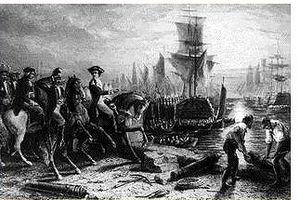In advance of the Continental Army’s occupation of Dorchester Heights, Massachusetts, General George Washington orders American artillery forces to begin bombarding Boston from their positions at Lechmere Point, northwest of the city center, on this day in 1776.
After two straight days of bombardment, American Brigadier General John Thomas slipped 2,000 troops, cannons and artillery into position just south of Boston at Dorchester Heights. The 56 cannon involved in the move were those taken at Ticonderoga, New York, by Lieutenant Colonel Benedict Arnold and Ethan Allen with his Green Mountain Boys, which had then been transported to Boston by Colonel of Artillery Henry Knox the previous winter.
By March 5, 1776, the Continental Army had artillery troops in position around Boston, including the elevated position at Dorchester Heights, overlooking the city. British General William Howe realized Boston was indefensible to the American positions and decided, on March 7, 1776, to leave the city. Ten days later, on March 17, 1776, the eight-year British occupation of Boston ended when British troops evacuated the city and sailed to the safety of Halifax, Nova Scotia.
The victory at Boston resulted in John Thomas’ promotion to major general; soon after, he was assigned to replace General Richard Montgomery, who was killed in action as he and Benedict Arnold attempted to take Quebec. Thomas arrived at Quebec on May 1 and soon lost his own life. Although a physician by profession, he died of smallpox on June 2, as the Patriots retreated up the Richelieu River from their failed siege of the city.

